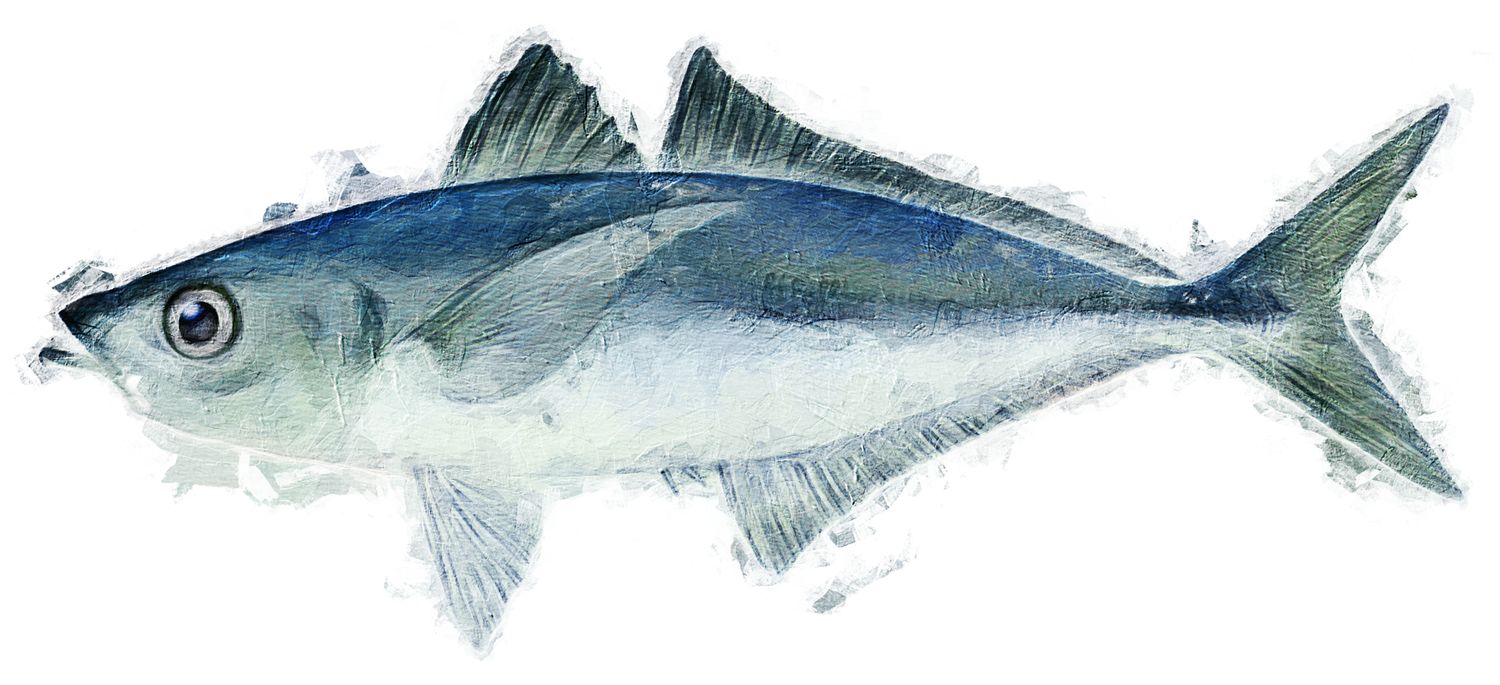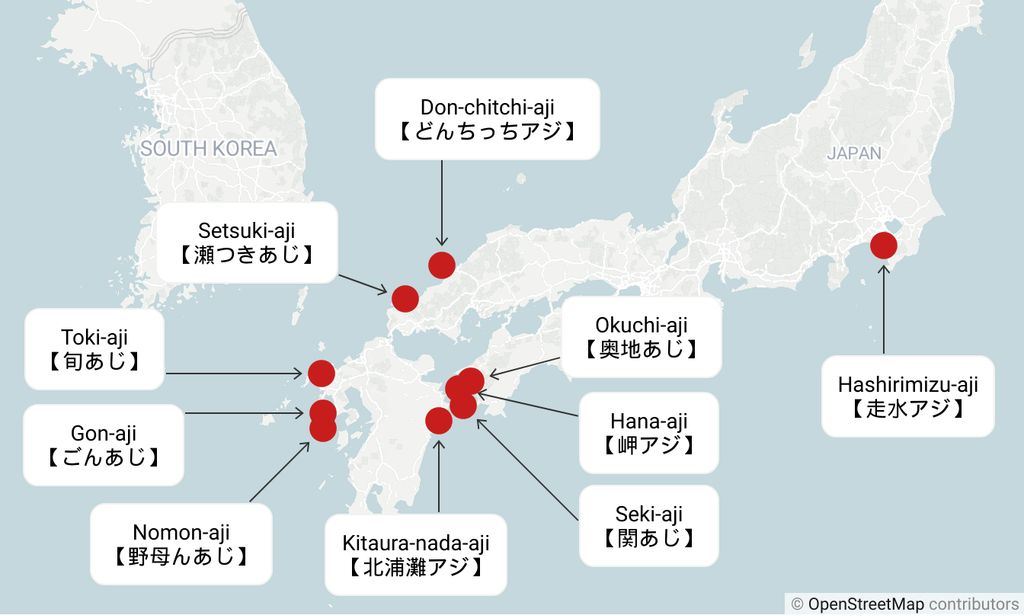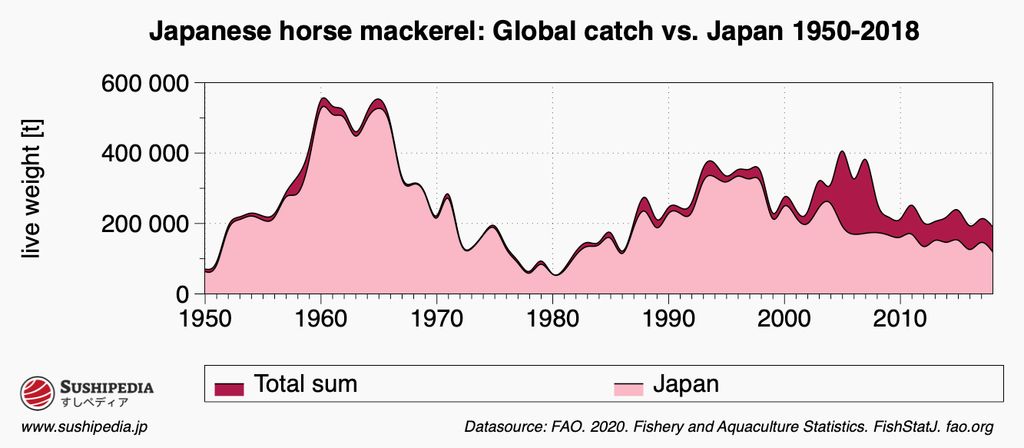Maaji Sushi
A Comprehensive Overview of Japanese Horse Mackerel in Japanese Sushi Cuisine
マアジすし 、 真鯵寿司 
What is Maaji?
The Japanese jack mackerel, also known as the Japanese horse mackerel or Japanese scad is known in Japanese as maaji 真鰺. Translated into English, maaji means “true or pure mackerel”. This fish is characterized by its distinctive taste, slender body and silver-blue color. As well as being used as an ingredient in many traditional dishes, maaji is a popular ingredient for sushi or sashimi.
Maaji for Sushi or Sashimi
The meat is tender, pinkish, and fatty. As nigiri sushi, it is often garnished with ginger (gari ガリ) and spring onions (negi 葱). In upscale or more sophisticated sushi restaurants, freshly grated ginger is sometimes placed between the rice and the meat. Thanks to its high fat content, maaji paired with vinegared sushi rice makes a tasty combination.
Nowadays, maaji meat is also used raw or untreated as an ingredient for sushi, although it is also traditionally very delicious when pickled in a vinegar-salt solution. The treatment in the vinegar-salt solution gives the tasty meat an additional refreshing aftertaste.
Best Season
Maaji tastes delicious all year round, but it is said to be most tasty from April to September, not right before and after spawning season.[1] Aji migrates with the warm ocean currents along the coast of Japan, so it is caught throughout Japan at all times of the year. The spawning season also varies depending on the marine region and conditions, so they are available in good quality for a relatively long time. During this time, fish begin to accumulate larger fat reserves for spawning in the fall. Unlike late summer, at this time the fat tissue is in perfect balance. During this period they are neither too lean nor too fat, and therefore remarkably tasty.
Maaji in Japan
Maaji is well known to most people in Japan, as it is a common fish both in restaurants and at home. It can be found in supermarkets and fish markets throughout the year.
Ki Maaji and Kuro Maaji
In Japan, a distinction is made between the yellowish variant ki maaji 黄真鰺 and the darker variant kuro maaji 黒真鰺. Ki maaji, the yellowish variant, shows fewer migratory movements and stays mainly in coastal regions and bays. Due to the lower energy expenditure for the migrations, they have a higher fat content as well as a greater width and length than kuro maaji. The latter live further out in the open sea and are therefore easier to reach for industrial fishing, making them a significant part of the total catch. Particularly popular in Japan is ki maaji from the southern bay of Tokyo, which is caught by hand in small quantities. This bay is characterized by an abundant supply of plankton, which is an important food source and therefore crucial for the growth and quality of ki maaji.
Etymology
The etymology of the term maaji 真鰺 can be broken down into two parts: 真 and 鰺. Ma 真 means “true”, “genuine” or “pure”. In this context, it is used to emphasize the authenticity or purity of the species compared to other similar species. Aji 鰺 refers to the fish species of the Japanese horse mackerel. Taken together, 真鰺 therefore indicates the “true” or “pure” form of the horse mackerel, meaning that it is the species considered native or authentic to Japan within the horse mackerel.
The relationship between aji 鰺 and the term 味 (taste) indicates an interesting phonetic correspondence that is not uncommon in the Japanese language. The character for aji 鰺, which denotes the species, shares its pronunciation with 味, which means “taste”. This phonetic correspondence between a noun (鰺) and an abstract concept (味) shows how homophonic words can have different meanings and spellings in the Japanese language. In the specific culinary context, this contributes to aji (鰺) being perceived primarily in relation to its quality and flavor, creating a meaningful connection between the name of the fish and its prized characteristic in Japanese cuisine.
Regional brands
In Japan, there are several regional brands of Japanese horse mackerel. The most highly valued are the seki aji 関あじ, caught in the narrows of the Bungo Channel, and the don chitchi aji どんちっちアジ from the west coast of Shimane Prefecture.[2][3]

SushiPedia. Map of Regional Aji (Horse Mackerel) Brands in Japan. All rights reserved ©
Characteristics & Ecology of Maaji
Maaji reaches a size of 35 cm (14″), single species can reach a size of up to 50 cm (20″). Their main food source are mainly small crustaceans and smaller fish. Usually they are found in depths from 50 (165′) to 275 m (900′).
Economy of Maaji

SushiPedia. Japanese horse mackerel catch statistics (1950-2018) - comparison of global and Japanese catches. All rights reserved ©
Maaji is a popular dish and belongs to the most important commercial fish species worldwide. The worldwide production (catch and aquaculture) of maaji in 2018 was 189 376 tons according to FAO. Japan's share (118 700 t) represents about 62% of the world total. In 1998 the share was still about 91%. It is mainly caught in trawls and purse seines.
Season Calendar for Maaji
The calendar shown does not provide information on fishing times, but marks the periods in which maaji is considered particularly tasty.
Video about Maaji Sushi
External video embedded from: youTube.com. Credit 関斉寛. 【しめ鰺の棒寿司②】アジにピッタリのシャリ・切りつけのコツ!.
Species of Maaji
The following species are regarded as authentic maaji. Either historically, according to the area of distribution or according to the common practice in today's gastronomy:
Sources and Further Reading
- [1]Hisayo Iwabuchi. The In-Season Fish, Aji (Horse Mackerel). Shun Gate, Toppan Inc, Tokyo, 2019. Source retrieved 12/27/2021
- [2]Saganoseki brand: There's a reason why “Seki“ is in the brand name (佐賀関ブランド:ブランド名に”関”がつくには理由がある). Oita Fisheries Cooperative Saganoseki Branch (大分県漁業協同組合 佐賀関支店)、 2015. Source retrieved 2/16/2021
- [3]『浜田の水産ブランド“どんちっち”~どんちっちアジ (Hamada's Fishery Brand “Don-Chicchi“ - Don-Chicchi Horse Mackerel)』. Hamada City Ministry of Industry and Economy Fisheries Promotion Division (浜田市 産業経済部 水産振興課)、 2019-01-23. Source retrieved 2/16/2021
- Ole G. Mouritsen. Sushi: Food for the Eye, the Body and the Soul. Jepsen & Co, Copenhagen. 2006
- Fishery and Aquaculture Statistics, Statistiques des pêches et de l’aquaculture, Estadísticas de pesca y acuicultura 2017. Food and Agriculture Organization of the United Nations (FAO), Rome. 2019
- Rainer Froese, Pauly Daniel. FishBase. The Leibniz Institute of Marine Sciences at the University of Kiel, FishBase.org, 2019. Source retrieved 12/24/2020
- 哲朗脇本. 『初夏の東京湾『金アジ』が絶品の理由 ノドグロと同等の価格になることも (Why Tokyo Bay's "golden horse mackerel" in early summer is so delicious: The price is sometimes the same as that of nodoguro.)』. tsurinews.jp, TSURINEWS 編集部, Tokyo、 2020-05-22
- 昌髙藤原. 『ぼうずコンニャクの市場魚貝類図鑑 (Bozu Konyaku's Market Fish and Shellfish Book)』. Bozu Konnyaku Co., Ltd., Tokyo ぼうずコンニャク株式会社東京, zukan-bouz.com、 2020. Source retrieved 12/27/2021
- IUCN Red List of Threatened Species. Version 2023-1
Image Credits
- Unknown author. Maaji Illustration. All rights reserved ©
- SushiPedia. Japanese horse mackerel catch statistics (1950-2018) - comparison of global and Japanese catches. All rights reserved ©
- SushiPedia. Map of Regional Aji (Horse Mackerel) Brands in Japan. All rights reserved ©